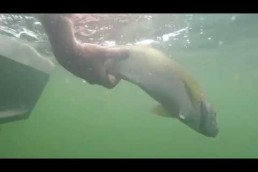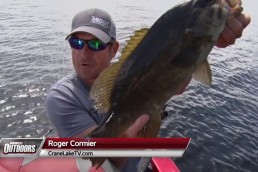Smallmouth Bass Feed on in the Madness of Fall
SHARE THIS POST
Smallmouth bass cop an attitude as summer turns to autumn. The warm days of July and August sparked a feeding frenzy with smallmouths roaming in large schools while gorging themselves on minnows in the shallows. These acrobatic fighters will often get in a “wolf pack” when the water is warm. The warmer the water, the more aggressive they get, and they will school up, stay shallow and feed.
But the cooler waters of fall do nothing to douse their fire. The downward turn in temperature is nature’s way of signaling winter is on the way and the feeding frenzy turns to absolute madness, which translates into vulnerable fish. Fall is prime time for big fish, and lots of them.
Water temperatures rarely reach 80 degrees in the Upper Midwest. That means smallmouths can stay shallow all summer long, somewhere from the surface to 5 feet down. There are huge numbers of smallmouths that roam in lakes, like Mille Lacs, attacking minnows where they can find them. If you find the food, you’ll find the smallmouths. And you can catch 10 to 50 from the same concentrated bunch.
The summer pursuit of smallies is visual. The key is to use polarized sunglasses to scan shallow spots for visible forage fish or to use sonar to spot slightly deeper schools on the top edges of structure. In lakes, start the search on classic smallmouth structure, like flats and points with sharp drops to the deep water. Add sand, rock and weeds, and you’ve got a good chance to connect. But when they are schooled, they really don’t care what kind of cover they are on because it’s the meal that they’re after. Baitfish will keep moving, and so should you.
Always try the shallow water first, and you rarely have to search deeper than 5 feet this month. Use spinning gear for grubs and tubes. Tie on a 1/8-ounce jig/grub with 10-pound-test TUF Line XP on opening day and you’ll be able to stay on them until the end of the season. Try using longer 7-foot rods to make long casts so you can stay farther back and avoid spooking shallow fish. Neutral-colored tubes or grubs in brown, white or chartreuse work great. In addition, a jig tipped with a leech can often turn the trick in tough conditions.
Many smallmouth bass aficionados use baitcasting rods for spinnerbaits and crankbaits. They typically spool up with the heaviest line they can get away with, usually between 10- to 17-pound-test. The primary factor in line choice is water clarity.
Use crankbaits and spinnerbaits to cover water fast and locate active fish. Go slower with plastics, if necessary. Try throwing 1/2-ounce lipless crankbaits in blue and chrome or in reds and browns. Topwater baits, like jerkbaits and Pop-Rs, work great in calmer water conditions. For summertime spinnerbaits, use 1/4 ounce with two-tandem number 3 willow-leaf blades, usually in a metallic.
Are you enjoying this post?
You can be among the first to get the latest info on where to go, what to use and how to use it!
Remember, smallmouths are not homebodies. Try several likely places on the structure. If nothing bites, move to another spot. Thirty minutes at one spot is too long.
Location changes in the fall as summer fades away. Smallmouths become more structure-oriented. They move off the flats and the tops of points to the edges of the drop-offs. Where you were once fishing from the surface down to 5 feet, focus on depths down to 15 feet in September. Schools will gather on any drop-off, no matter how slight the change.
Bait choices will change too. Forage fish are bigger by this time of year, so move up to 1/2-ounce spinnerbaits with two- tandem number 5 willow-leaf blades. For tubes and grubs, stick with brown and watermelon, but doctor them up by tipping them with an orange dye. Heavier, lipless crankbaits still work well too.
As September surrenders to October and beyond, smallmouths move deeper still. Their love of structure turns into a passion, as they hold on vertical drops from 10 to 20 feet deep. Favored presentations become jigging spoons while using sonar to position the boat over the pack. In addition, rigging with a large chub or sucker can be deadly at this time. You can often catch the biggest fish of the year—if you can stand the weather.
The summer-to-autumn transition offers a different challenge in rivers. Early in summer, river smallmouths act more like largemouths. They like dead spots, no-current areas like sloughs and backwaters, with current nearby. But smallmouths soon move to the main river and hold on current breaks, such as the upstream or downstream sides of wing dams, eddies behind shoreline points and blowdowns. You’ll still find them in these in the fall.
There’s no other time for smallmouth bass like the transition time. And even when the weather turns colder, bronzeback fishing stays hot.
MWO
SHARE THIS POST
Did you enjoy this post?
You can be among the first to get the latest info on where to go, what to use and how to use it!
Ted Takasaki
Ted Takasaki is an International Fishing Hall of Fame professional angler who has been featured in many national outdoor magazines and television shows. Takasaki has appeared in front of thousands of angling enthusiasts and is considered one of America’s top walleye and multispecies anglers. Follow him on his Facebook page.



